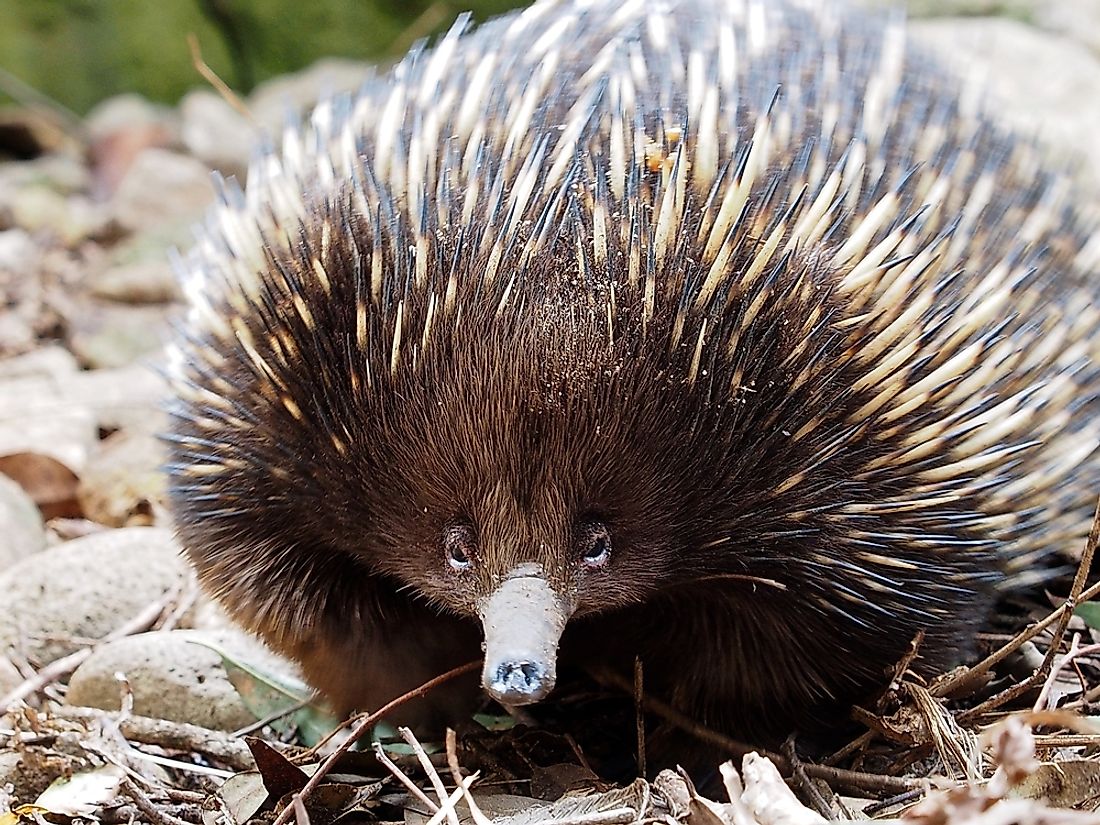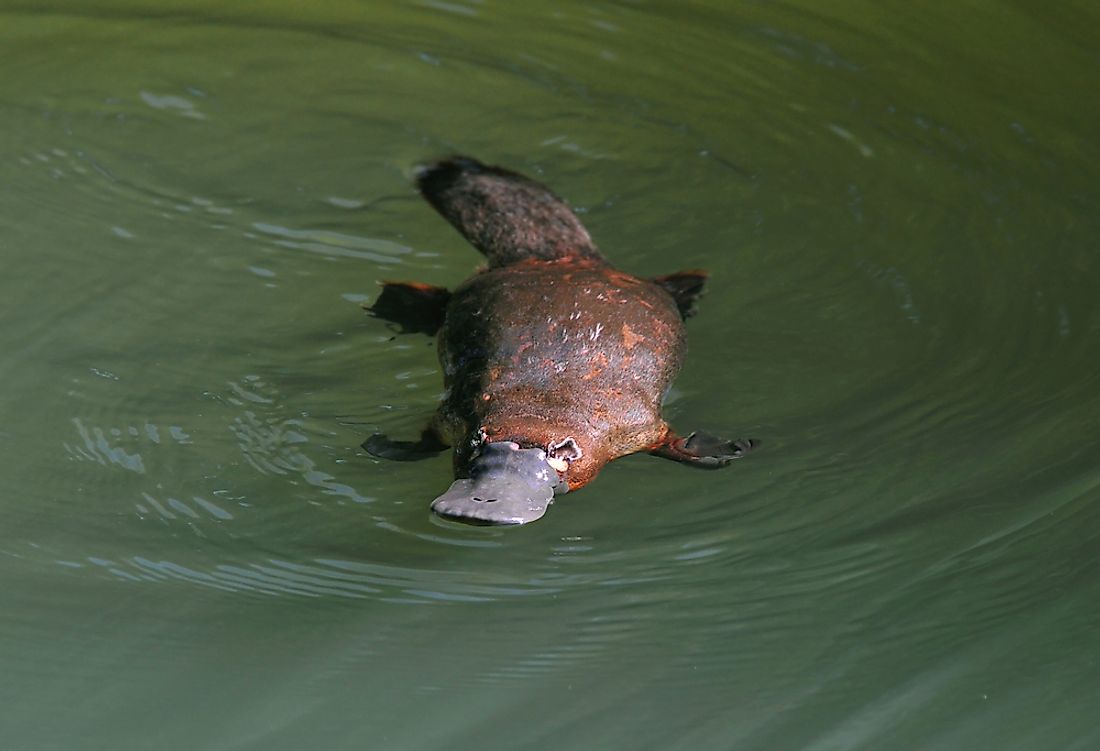The 5 Species Of Monotremes Living Today

Basal egg-laying mammals are called monotremes. Unlike marsupial and placental animals, these mammals do not give birth to live young ones. All of the surviving members of the monotreme group are indigenous to the island of New Guinea and Australia. Four species of echidnas and the duck-billed platypus account for the five monotreme species living in the world today. The main features of these species are described below.
5. Western Long-beaked Echidna
The western long-beaked echidna (Zaglossus bruijni) is found on the island of New Guinea. Here, it lives in the Foja Mountains and Bird's Head Peninsula of the Papua and West Papua provinces of Indonesia. The animals can be spotted living in alpine meadows and humid montane forests at elevations ranging between 4,300 and 13,100 feet. The western long-beaked echidna is the largest living monotreme species. It possesses three claws on the fore and hind feet, a feature that distinguishes it from other Zaglossus species. The western long-beaked echidna has a longer, downward bent snout than the short-beaked echidna. The echidnas feed primarily on earthworms. Habitat loss and hunting have drastically reduced the numbers of this species and it is currently classified as "Critically Endangered" by the IUCN. The animal is considered to be a delicacy in the parts of the world and although commercial hunting of the species is banned, traditional hunting continues.
4. Eastern Long-beaked Echidna
The eastern long-beaked echidna (Zaglossus bartoni) is an echidna species found at elevations between 6,600 and 9,800 feet in New Guinea. Here, they live in sub-alpine forests, upland scrub, in grassland areas, or in tropical hill forests. The animals are distinguished from other Zaglossus species by the presence of four claws on the hind feet and five claws on the fore feet. The animal has dense black fur and is about 60 to 100 centimetres long. The insectivorous species uses its long snout to dig deep into the ground in search of ticks and larvae. The eastern long-beaked echidna is classified as a "vulnerable" species by the IUCN. Deforestation and hunting are the two biggest threats to these animals. Feral dogs are also known to prey on the echidnas. Four subspecies of the eastern long-beaked echidna are recognized. They are Z. b. bartoni, Z. b. clunius, Z. b. diamondi, and Z. b. smeenki.
3. Sir David's Long-beaked Echidna
Sir David's long-beaked echidna (Zaglossus attenboroughi) is one of the three species of the genus Zaglossus. The animals live in the Cyclops Mountains of New Guinea and are named after the eminent naturalist, Sir David Attenborough. This echidna species is the smallest among the species of its genus and is closer in size to the short-beaked echidna. The animals feed on termites, ants, insect larvae and earthworms. They prefer to live in isolation and only come together to mate. A critically endangered species, Sir David's long-beaked echidna was almost considered to be extinct in the 1900s until the evidence of their unique nose pokes was discovered in the Cyclops Mountains. Hunting and habitat loss are the primary reasons for the decline of this species.
2. Short-beaked Echidna

The short-beaked echidna (Tachyglossus aculeatus), a member of the genus Tachyglossus, is a monotreme that lives throughout Australia as well as southwestern New Guinea’s coastal and highland regions. The animals have a distinctive snout and specialized tongue that helps them catch insects at great speed. The body of the animal is covered in fur and spines. The short-beaked echidna also has extremely strong claws and front limbs which allows for the animal to quickly burrow into the ground with great strength. The echidna curls into a ball with exposed spines when threatened. It is a good swimmer and can also tolerate low oxygen levels. It tries to avoid heat and during winter it hibernates to save energy. Five subspecies of the short-beaked echidna are recognized: T. a. acanthion, T. a. aculeatus, T. a. lawesii, T. a. multiaculeatus, and T. a. setosus.
1. Duck-billed Platypus

The duck-billed platypus (Ornithorhynchus anatinus), is a monotreme species that is endemic to eastern Australia. It is the only extant species of the Ornithorhynchidae family and Ornithorhynchus genus. The animal has an extremely unusual appearance. It is an egg-laying mammal that has a bill like a duck, tail like a beaver, and feet like an otter. The first time European naturalists encountered it, it was considered to be an elaborate hoax. The males of this species possess a spur on the hind foot that can deliver a venom that causes severe pain in humans. The uniqueness of the duck-billed platypus make it one of the iconic species of Australia and it has been often used as a mascot in national events. The animal is now classified as near-threatened on the IUCN Red List. It was once hunted extensively for its fur but is currently protected by law throughout its range. The duck-billed platypus feeds on insect larvae, freshwater shrimp, annelid worms, etc. It uses its snout to dig out its prey from the riverbed and carries the prey in its cheek pouch which it feeds on once on the surface. The platypus spends about 12 hours a day in search of food.











